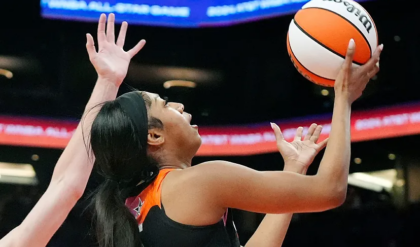In her quarrel with the Wests, Swift was cast in the role of perfidious white woman falsely claiming victimhood.
And since she has made her near-downfall an integral piece of her star narrative, the darkness before the inevitable triumph, some have questioned whether it was really that bad. (This magazine once called her single “Look What You Made Me Do” a “pure piece of Trump-era art,” which was not intended as a compliment.)
After retreating from the public eye for months, she resurfaced in the summer of 2017 for a civil suit against a radio DJ who’d groped her years earlier.
Confronted with a situation in which Swift incontrovertibly was a victim, seeking nothing more than a symbolic $1 in damages, public opinion began to turn around once more.
She made such a winning appearance on the witness stand, refusing to be shaken by aggressive questioning, that even outlets who’d once denounced her published roundups of her best quips.
The Garbo (2018)
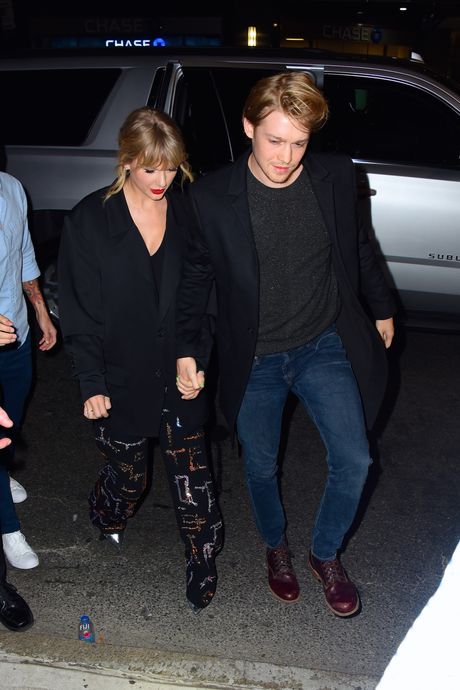
During Swift’s year away, she began dating up-and-coming actor Joe Alwyn. Throughout their seven-year relationship, the pair were rarely photographed together and said as little as possible about each other in interviews. “We decided together we wanted our relationship to be private,” Swift would say. Going dark not only helped Swift ward off the overexposure that caused her trouble in the past, it also meant that, if you wanted to follow their love story, you could only do so through her music, a medium where Swift had full control. (And where Alwyn, credited as “William Bowery,” would occasionally pop up as a co-writer.) As Swift returned to the spotlight, she was careful to underline the difference between her public and private selves. In the liner notes to Reputation, she wrote, “We think we know someone, but the truth is that we only know the version of them that they have chosen to show us.”
The Vulnerable One (2018–19)

What version of Swift did she show us in the documentary Miss Americana? Lana Wilson’s film, which follows the star through 2018–19 and was released in 2020, provides a glimpse of what Swift considers to be her human side with frequent shots of her journaling and hanging out at home with her cats. (Alwyn is barely seen.) Amid the stage-managed authenticity of scenes in which Swift defends her decision to wade into politics to a room full of middle-age white men, there are a few genuine revelations. She discusses her history of disordered eating and her innate people-pleasing tendencies with the self-awareness of someone who has undergone a lot of therapy. Tellingly, the doc is bookended by scenes of Swift failing, first at the Grammys, then at politics. When she dejectedly declares that all she needs to do is make a better record than Reputation, it’s almost enough to make her feel like an underdog again.
The Ally (2019)
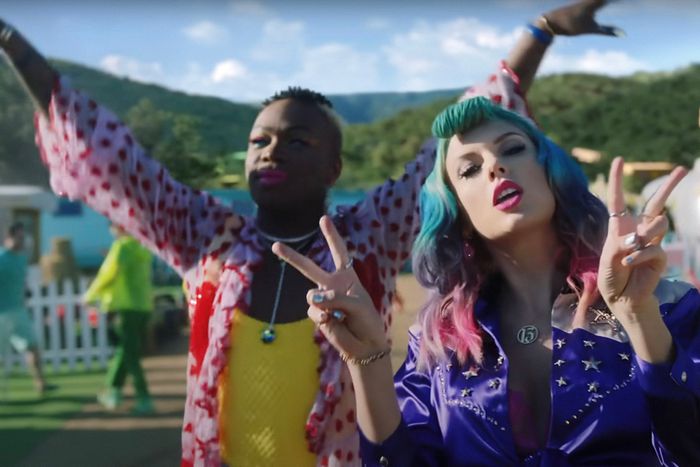
In the polarized atmosphere of the Trump presidency, the urgency of the moment overcame Swift’s natural prudence. After being knocked for her silence during the 2016 election — “Taylor Swift is never, ever, ever going to tell you whom she’s voting for, because speaking up is never, ever, ever going to benefit Taylor Swift,” quipped Vox.com — she entered the electoral arena during the subsequent midterms, calling on her fans in Tennessee to vote against anti-gay, anti-feminist Senate candidate Marsha Blackburn. She continued in this vein during her Lover era, campaigning for a bill outlawing discrimination against the LGBT community and issuing the thinly veiled Trump diss track “You Need to Calm Down” as a single. “Why are you mad when you could be GLAAD?” she sang, cavorting in the video with drag queens and the Queer Eye guys … and also Katy Perry, with whom she’d buried the hatchet, ending a yearslong feud. Unfortunately, both of Swift’s interventions came up short. (Blackburn was elected with nearly 55 percent of the vote — the political defeat Swift referenced in Miss Americana.) In retrospect, the greatest legacy of this moment was Swift waving the rainbow flag so fervently that a contingent of fans became convinced she was secretly queer. (Is that why her hair was the same color as the bi𝓈ℯ𝓍ual pride flag?, conspiracists wondered.)
The Owner (2019)
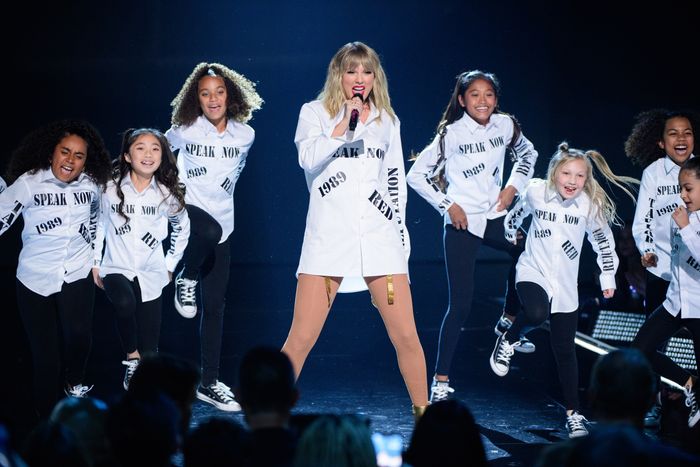
The old Taylor had made hay out of feuds with other artists; the new Taylor would only battle enemies from within the executive class, none of whom could boast their own stan armies. Performing a career-spanning medley at the 2019 American Music Awards, Swift wore a shirt emblazoned with the names of her first six albums. It was a defiant salvo in a war that had begun three months earlier, when Swift announced a plan to rerecord her old music in protest of former Big Machine Records head Scott Borchetta’s sale of her old masters to manager Scooter Braun, a Swift nemesis. “This is what happens when you sign a deal at fifteen to someone for whom the term ‘loyalty’ is clearly just a contractual concept,” she wrote on Tumblr. The AMAs performance was preceded by a public back-and-forth in which Swift claimed she had been forbidden from performing her old music unless she abandoned the project. (Big Machine Records denied this.) In the current Swift narrative, this is the other dark moment she had to overcome, and her personal activism, at least, had a happy ending. The rerecording project got underway in 2021, allowing Swift to rewrite the story of her career under self-ownership.
The Auteur (2020–22)
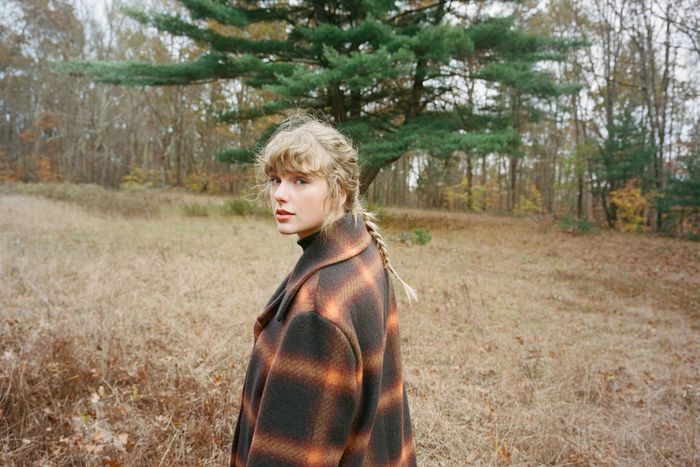
Swift’s COVID albums folklore and evermore saw her turn away from autobiographical songwriting, employing fictional narratives inspired by the cinematic “folktales” like The Devil’s Backbone and Pan’s Labyrinth she’d been exploring in quarantine. Full of contemplative woodland imagery and duets with adult-contemporary acts like Bon Iver and the National (whose guitarist Aaron Dessner co-wrote and produced significant chunks of both albums), the new music introduced a more highbrow, Pitchfork-friendly version of Swift. As the writer B.D. McClay noted, this era “brought back the fans who hadn’t loved her turn to pop or who had lost touch with her as they got older,” while also attracting “new fans who were interested in a Taylor Swift album without all the Taylor Swift personal baggage.” Swift’s serious-artist bona fides were further underscored by her burgeoning directorial career, which wiped away memories of earlier questionable Hollywood forays like Cats. Having begun helming her own music videos on Lover, she campaigned for a Live Action Short Oscar nomination for her “All Too Well” ten-minute version video, name-dropped her fave art-house films at film-festival talkbacks, and appeared opposite Martin McDonagh for Variety’s “Directors on Directors” series. These efforts didn’t earn her an Oscar nom, but they did set up what appears to be the next stage of her career: In 2022, she landed a feature-film deal with Searchlight, whose presidents hailed her as a “once in a generation artist and storyteller.”
The Titan (2023)
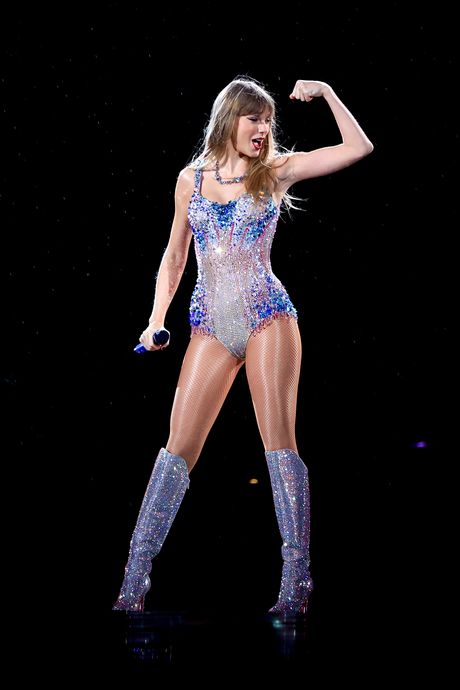
Swift went on tour in 2023, having released four new albums since she’d last hit the road and being in the middle of her rerecording project. Other artists’ live shows might have struggled from a lack of focus, but as always, Swift found a way to make it work for her: She embarked on the Eras Tour, a celebration of her entire career — ten acts, with past and present on equal terms, and Swift miming the lyrics the way her fans had done since 𝘤𝘩𝘪𝘭𝘥hood. In the words of critic Steven Hyden, the Eras concept dismantled “the ‘new work vs. old work’ binary for artists,” allowing Swift “to be a ‘legacy act’ and a ‘relevant pop act’ simultaneously.” As one college-age fan gushed to the New York Times, “You could so easily be ashamed of singing Taylor Swift in your bedroom. You could leave it behind. But she doesn’t let you … What if we weren’t ashamed of our eras? What if we realized they were always with us?” Eras is considered the highest-grossing concert tour ever, adding billions of dollars to the U.S. economy and reportedly making Swift herself a billionaire, too. Every night, she flexed her biceps in the lead-up to the Lover cut “The Man,” towering over the music industry like a colossus.
The Crisis Manager (2023)

After news broke of her breakup with Alwyn in April 2023, Swift rebounded with his exact opposite: outspoken edgelord Matty Healy of the band the 1975. When Healy made racist comments about rapper Ice Spice on a podcast, the resulting controversy seemed for a second to engulf Swift herself. She quickly went into damage control, collaborating with Ice Spice on the remix of her latest single, “Karma,” and bringing her onstage at the Eras Tour in New Jersey. (The Healy relationship, which was never confirmed by either party, ended soon after.) The idea of Swift as a PR mastermind became such a significant element of her star image that her publicist, the all-seeing, all-knowing Tree Paine, became a minor celebrity in her own right.
The Squad Leader (2023)
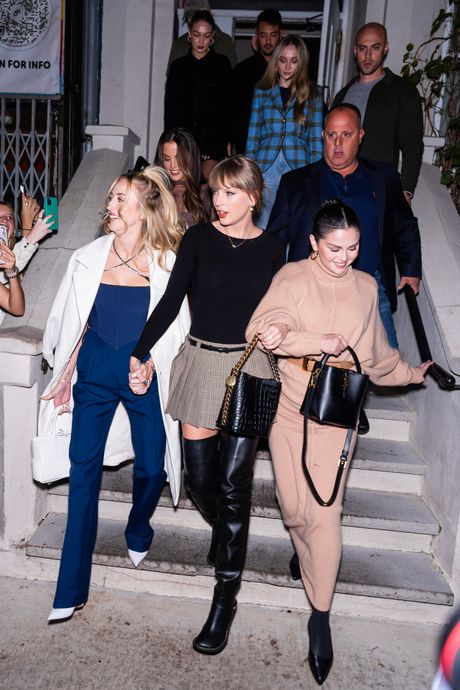
Swift’s 1989 was the era of her squad — a collection of similarly famous women who represented the power of female friendship, the freedom to not be defined by her romantic relationships. (Little did she know fans would simply assume she was dating girls instead.) Coincidentally or not, the run-up to the 1989 rerelease in October 2023 saw the re𝐛𝐢𝐫𝐭𝐡 of the squad, as Swift began making more public appearances flocked by her celebrity friends. She was not subtle about employing the spotlight as a shield. When Sophie Turner was hounded by the tabloids amid her divorce from Joe Jonas, a Swift ex from years ago, Swift took Turner under her wing, keeping her close in a signal of solidarity. Not everyone received the same benefits: As rumors swirled that Swift was feuding with Olivia Rodrigo over songwriting credits, the latter was a conspicuous absence in her personal life.
The Mogul (2023)
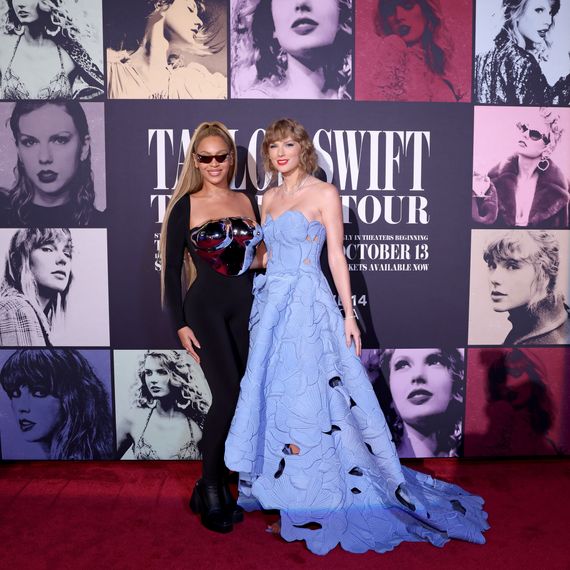
When it came time to release a concert movie from the Eras Tour, Swift seized control of the means of production. She self-funded the project, then made a distribution deal with AMC directly, cutting out the big Hollywood studios. (Here, too, she was savvy in her enemies, as at that moment the studios were widely despised due to the SAG and WGA strikes.) The most notable guest at the premiere? Beyoncé, whose Renaissance Tour overlapped with Swift’s, and who would soon release her own concert film through similar methods — a gesture that they would no longer be pitted against each other, at least outside the Grammys. “The way she’s taught me and every artist out here to break rules and defy industry norms,” Swift wrote on Instagram, alongside a Boomerang of Beyoncé tossing popcorn.
The Empire (2023)
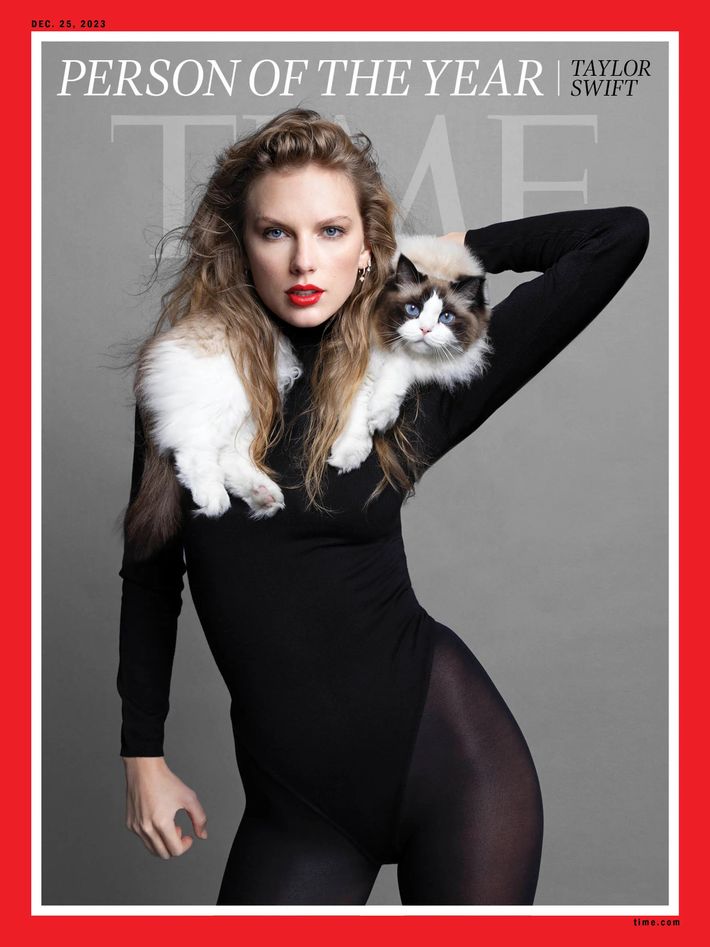
Swift doesn’t give many interviews, and when she does, they’re usually with Time, which hits her sweet spot: venerable, middlebrow, and pliant. (You can imagine her parents were subscribers in the ’90s.) Her 2023 “Person of the Year” cover was a culmination of her playing a nearly perfect game on the celebrity front. “It feels like the breakthrough moment of my career, happening at 33,” Swift told the mag. “Ultimately, we can convolute it all we want, or try to overcomplicate it, but there’s only one question … ‘Are you not entertained?’” However, the accompanying photos demonstrated a disconnect between Swift’s brand of relatable stardom, which all but demands a feline accessory, and the high-glam style of the culture industry. Alone among A-list pop stars, Swift is not expected to slay: As Puck’s Lauren Sherman wrote, her current aesthetic is aimed at “14-year-olds, or someone of any age who wishes to look like a senior at Emerson College in 2006.” She serves big sister, not strictly mother.
The Girlfriend (2024)
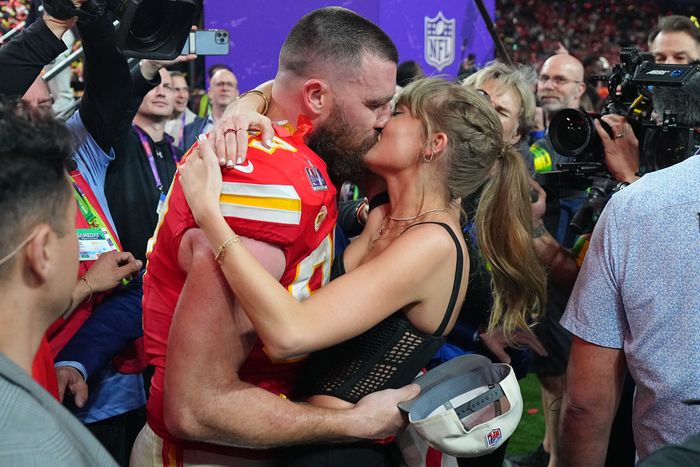
Swift’s relationship with NFL tight end Travis Kelce can be seen as a corporate merger of the last two vestiges of the monoculture, and her frequent presence on Chiefs broadcasts was widely credited for expanding the league’s female audience. This relationship has played out in full view of the media, as unlike Alwyn or Healy, Kelce — who harbors ambitions to be as famous as the Rock — has been an enthusiastic participant in Swift’s star project, flying to Argentina on his bye week so she could run into his arms after a Buenos Aires concert. Such a public performance of romance was the biggest fan service Swift could provide, and it inaugurated a period of mass saturation that has marked a stark shift from her earlier reclusion. In her Time interview, Swift confirmed her approach had changed since the Reputation era. “Me locking myself away in my house for a lot of years — I’ll never get that time back.”
The Mastermind (2024)
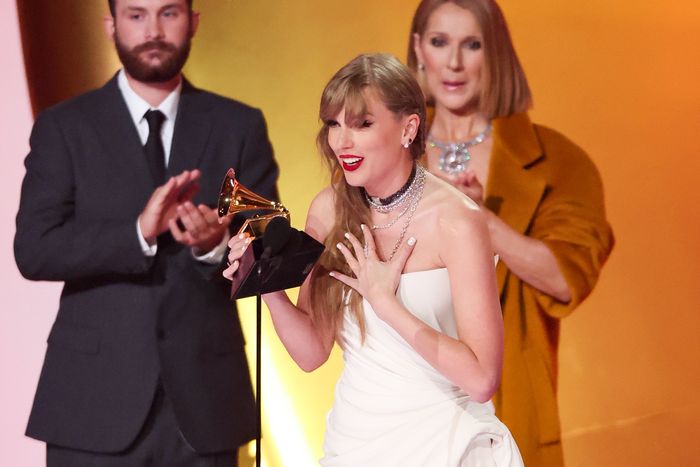
When Swift walked the 2024 Grammys red carpet in a white Schiaparelli gown and black gloves, haters pounced. (As one anonymous writer put it, her outfit “looked like hotel curtains saddled with opera gloves and a watch choker that cut her neck in half.”) Still, as they had been trained to do, fans obsessively studied the look for clues about the rerecorded version of Reputation, which is linked with monochrome imagery in Swiftie lore. But they had it all wrong. When Swift won Best Pop Vocal Album for Midnights — her 13th Grammy, she noted auspiciously — she used her acceptance speech to announce a brand-new record, The Tortured Poets Department. Which perhaps explains the over-the-top romanticism of the look. She wasn’t dressing for the Grammys, or for Midnights; she was dressing for her new era.

